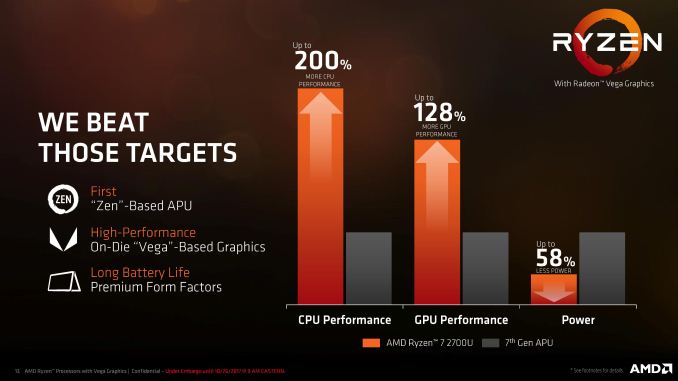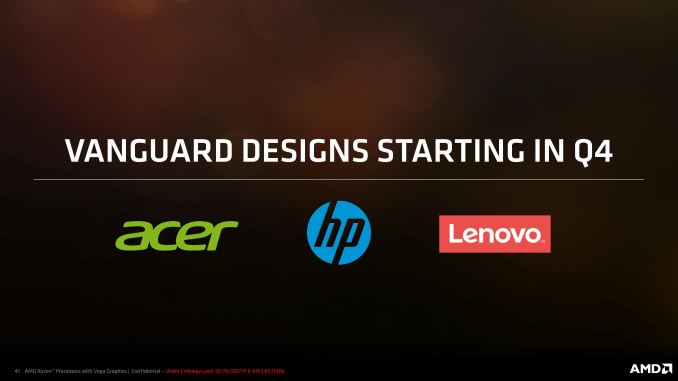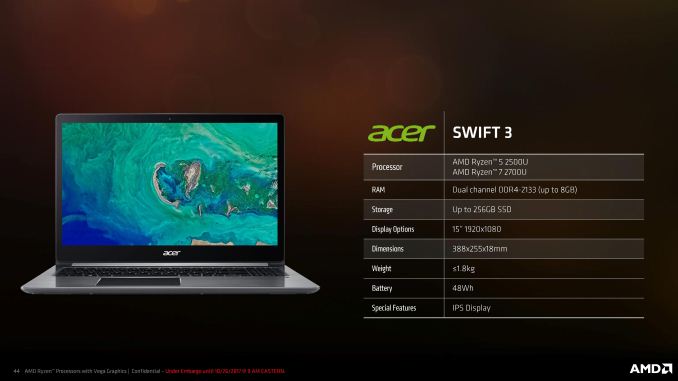Ryzen Mobile is Launched: AMD APUs for Laptops, with Vega and Updated Zen
by Ian Cutress on October 26, 2017 9:00 AM ESTAMD Ryzen Mobile: Zen 1.5
During our pre-briefings on Ryzen Mobile, it was asked why the two new APUs were using the 2000-series numbers, and not the 1000-series numbers like the desktop parts. It was assumed by the press that the first generation of Ryzen would all be under the 1000-series, including the mobile parts. The response given by Kevin Lensing, AMD’s Corporate VP of the Client Business Unit, was that so many of the design ideas that AMD wanted to put into the original desktop Ryzen (but couldn’t due to time) eventually ended up in Ryzen Mobile, such as the updated precision boost. While there are no architectural changes to Zen to warrant a next-generation microarchitecture name, this version of Ryzen’s periphery (i.e. the power) was more in-line with an original vision and had to be presented as such. This is why we have Ryzen 7 2700U, rather than a Ryzen 7 1700U. He would not comment if the true next generation Ryzen desktop naming would still be the 2000 series, or if we would go straight to 3000. Who knows, it might alternate.
The state of Zen aside, AMD’s return to high-performance computing with the Zen core was naturally going to trickle down into the notebook space. The question everyone asked is if such a high-power, high-performance core was going to make it in such a small power envelope: especially when you add some big graphics core next to it. In our desktop Ryzen reviews, we saw per-core power go as low as 8W per core, and AMD’s Vega was power hungry – promising to put four cores and some graphics into a single piece of silicon with a 15W TDP sounded harder than an uphill task, almost Sisyphean in nature. AMD has approached that by taking new methods to its power topology, how it manages that power, and found a combination of frequencies and performance that tally up to that 15W mark. They have also worked closely with the first three OEMs that are launching systems today to ensure a good user experience.
For performance, Ryzen Mobile has four cores with multithreading, with frequencies up to 3.8 GHz. This should give the mobile processor enough grunt under the hood in the 15W envelope to cater for a significant number of demanding workloads. GPU performance is also up, with AMD also hoping to push the hardware into a number of gaming-focused devices with FreeSync panels in the new few months. AMD is also touting significant power reductions during high-load tasks, leading to a 270% performance per watt improvement. More impressive is the steps taken towards how the processor manages power between cores and the GPU: a very complex implementation hopefully leading to a better power profile and 15-30% better battery life than previous generations for common use cases.
For the launch, AMD has partnered with HP, Acer and Lenovo for systems to go on shelves. As I am currently writing this, only HP provided any information about their upcoming systems and we’re likely to scramble when the other press releases come out. None of the three designs are ultimate eye-catching flagships, but rather approaching that middle-range $600-$1000 notebook territory with 13.3 inch 4K displays, up to 1TB SSDs, 48-55Wh batteries, and a device or two that can flip into a tablet. When we played briefly with the Acer unit in our pre-briefing, there was no lag – a user would be hard-pressed to immediately see a difference to a comparative Intel system.
Ultimately AMD has several very hard tasks ahead of it for Ryzen Mobile. Firstly it has to re-educate the sales teams at brick and mortar stores like Best Buy, who have only ever seen AMD has the low-cost budget option. If they still think the same way when Ryzen Mobile comes to town, they won’t be recommending them.
Second, they have to educate the public – after years of miserable user experiences leading to negative feedback loops, AMD has to convince these users that it is worth looking at AMD-powered devices again and there isn’t some sort of catch. Part of this solution will be in how well AMD integrates itself into the OEM sampling strategy for reviews, and if any reviewers are going to get devices this time around.
Third, AMD is several steps behind Intel in its marketing message: while Intel is trying to explain new ways to use the hardware (such as the failed ‘PC Does Whaaat?’ campaign almost a couple of years ago to the day), AMD is on the ‘I’m here too, and I’m just as good’ message. Back when we analyzed the Carrizo user experience, one thing we pointed out is that with most Intel flagships, most users do not even know what processor is inside – to these customers, saying ‘I’m just as good’ might give the impression ‘well what was wrong before?’. It might take AMD a round of flagships and XPS 13 or Zenbook Infinity-type designs to get the attention on their side of the discussion.
We have reached out to all three of the main OEMs who have Ryzen Mobile systems being announced today, but only one responded in time. This doesn’t bode well for any sampling, but we’re sitting here with a megaphone until we get one. Stay Tuned.
As part of this launch, AMD also discussed its progress towards its 25x20 goal, and AMD actually provided some data on how they are calculating this. We analyzed what AMD still has to do in a separate article, and you can read about it here:
http://www.anandtech.com/show/11965/amds-progress-on-its-25x20-goal-the-task-ahead














140 Comments
View All Comments
jjj - Thursday, October 26, 2017 - link
It's on 14nm,the actual silicon is maybe 15$ and then there is test and packaging.The cost of the die is not much of an issue.They can easily price the average SKU between 80-100$ with the fastest SKUs a bit above and the lesser SKUs bellow. Not that Intel has much different pricing, the prices they list have nothing to do with reality,.wumpus - Thursday, October 26, 2017 - link
While it likely costs the same to make as a R3 Ryzen (closer to an R7, because all CPU cores have to work), it will take a long time to dig themselves out of their hole by pricing it at $80-100.Don't forget they have to pay for the mask with "ryzen mobile" sales, while ryzen and epyc paid for Zepplin die tooling. I don't expect it to be a cheap chip unless AMD is absolutely forced to (like they have been forced to for years and are hungry for Intel level margins).
velanapontinha - Thursday, October 26, 2017 - link
A very small difference between both processors, yet one is Ryzen 5 and the other is Ryzen 7. I really hope these are the lowest R7 and the highest R5.zodiacfml - Friday, October 27, 2017 - link
Appears to me that these are the best parts already. I can get by with a mobile R3 without hyperthreading.stanleyipkiss - Thursday, October 26, 2017 - link
A 14" Acer Swift 3 with the Kaby Lake-R (4 core/8 thread) 8 GB RAM and a MX150 from nVidia gets better FPS in every game outlined by AMD here. Why go for this? It's not lighter, it's not more efficient, it's not faster.In the real world, GPU performance is sub-par a 1030 (MX150). The only upside is the fact that you don't have to deal with Intel's iGPU and nVidia's discrete GPU in the same package. Other than that... not worth the hassle.
BrokenCrayons - Thursday, October 26, 2017 - link
There appears to be a power advantage over a KB + MX150 since the combined consumption of the CPU and dGPU are higher than mobile Ryzen alone. All things equal, you're going to give up some GPU performance in exchange for more battery life. It's a trade-off some people will be willing to make and others will reject. Cool either way, just buy what works best for you and don't worry about it.With that said, I think Vega would do better with dedicated video memory of some sort which is why I would have liked to see these chips released with a small HBM cache that can be used to supplement the system's DDR4, but that's probably an unrealistic pipe dream for the time being. The added costs of associated would make mobile Ryzen more expensive...maybe more than a CPU + dGPU combination capable of the same performance.
Jon Tseng - Thursday, October 26, 2017 - link
Anyone got any hard numbs on how this compares to KBL + MX150? I saw some commentary that Ryzen Mobile was comparable to the 950M... IIRC MX150 was a perf bump on the old 940MX. So are they on a similar level or does MX150 have a material advantage?Was thinking that if they are in the same zip code perf wise then Ryzen is a no brainer given power draw..
stanleyipkiss - Thursday, October 26, 2017 - link
The MX150 is on par if not better than the old 960M. It's a huge step up from all iGPUs.BrokenCrayons - Thursday, October 26, 2017 - link
The 960M is consistently faster in synthetics (by a small margin) and in gaming benchmarks (by a much larger margin) than the MX150. Here's a couple of notebookcheck links to compare:https://www.notebookcheck.net/NVIDIA-GeForce-GTX-9...
https://www.notebookcheck.net/NVIDIA-GeForce-MX150...
vladx - Thursday, October 26, 2017 - link
Indeed GPU performance is vey dissapointing, but par for the course for Vega.